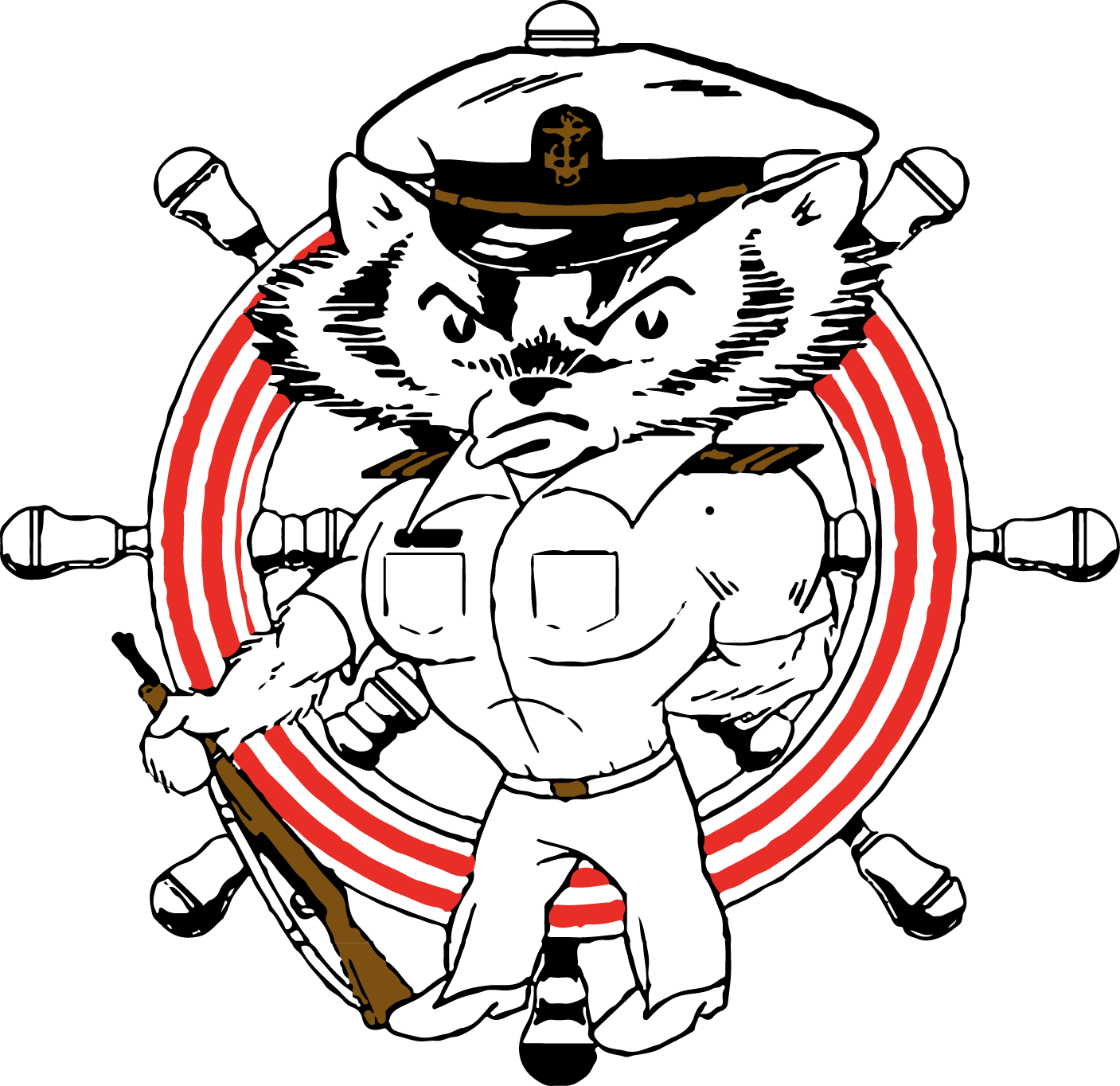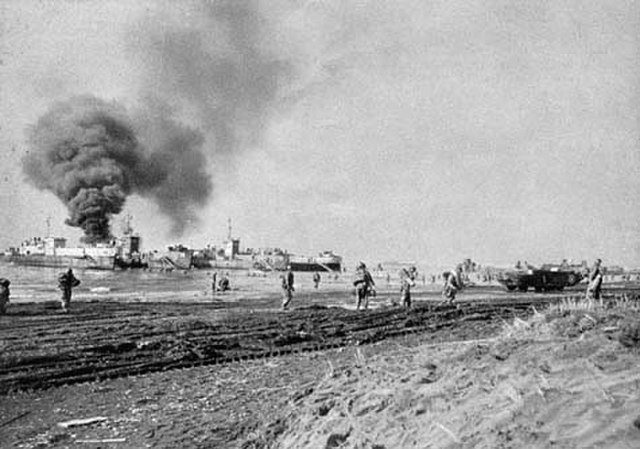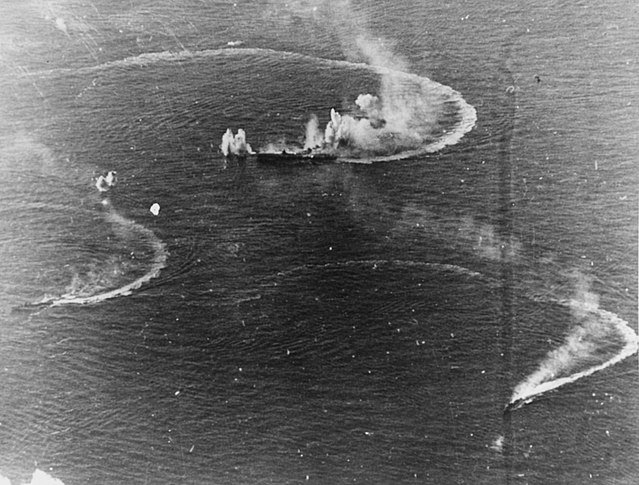1944: The End in Sight
Landing at Anzio Beach, January 1944
Radio School Hits Its Stride
After the departure of the women, the Radio School was able to achieve a relatively peaceful routine. In the Spring of 1944, the school expanded somewhat and changed to weekly student input rather than monthly. The change promoted efficiency by avoiding “bottlenecks and peak 1oads” on instructional and administrative staff.
Additionally, training time increased when the course length was changed to 19 weeks and later to 20 weeks. By the second anniversary of the Radio School in April, it had trained over 5,500 sailors, plus the women, as radio operators. J.L. Miller was no longer responsible for the educational program (Pollard had relieved him of that duty on 1 March 1944), and the Navy was now fully in charge of all aspects of the school. Miller disagreed with and resented this shift in power to the end. Radio School capacity rose in 1944 to 1,600, ironically filling space made available by Army ASTP cutbacks. The Navy had plans to increase it to 1,900; however, the success of the war effort forced a revision in training requirements, and that expansion never occurred.
Band in “Navy” Formation
Omaha Beach 6 June 1944
April 1944
In April 1944, noting the second anniversary of the UW Naval Training Schools, Pollard again pressed the NROTC issue in an address before the Madison Rotary Club.
“On numerous occasions, I have called the attention of the people of the state of Wisconsin to the great value of a permanent naval ROTC unit at this university. Such a naval unit would enable Wisconsin boys to take advantage of the excellent facilities available at the university for the training of high quality naval officers." He added, “I would like to urge all citizens of this state to unite on a request for a permanent naval ROTC unit at the university. I am convinced that such a unit would be highly beneficial to both the university and the navy.”
Again the Wisconsin State Journal supportively responded “The establishment of a permanent naval Reserve Officer’s Training Corps (ROTC) at the University of Wisconsin is not something to be dreamed about in the dim future, but a project that should receive attention at once.”
U.S. Navy Commissioning Placard USS WISCONSIN (BB 64) 16 April 1944
June 1944
Aware that the Navy was actively considering a war-end expansion of NROTC, Dykstra reopened dialogue in June 1944. Writing to Navy Secretary Forrestal in June 1944, he stated, “It occurs to us here that perhaps before long there will be a further establishment, by the Navy, of these ROTC Units. The University of Wisconsin, therefore, wishes to be on record once more asking for one of these assignments." In a similar vein, he wrote to Vice Admiral Randall Jacobs, Chief of the Bureau of Naval Personnel, and asked the Navy to “give us every consideration when the time is again opportune.” Navy response was non-committal but supportive.
Battle of Phillippine Sea June 1944, Japanese aircraft carrier ZUikaki and two destroyers attempt to evade aerial bombardment
The Scope of V-12 Training Pathways - An Example
The following brief case study illustrates the magnitude and complexity of the Navy's reserve officer production system after V-12 commenced operation and its geographic dispersion. On 1 July 1943, the same day V-12 became operational, LuVerne Arthur Wedell, age 17, having completed one year of college at North Dakota State Normal and Industrial School, commenced active naval service as an apprentice seaman at Valley City State Teachers College, Valley City, North Dakota. He enrolled in the V-12 deck officer program. By February 1944, he had completed two semesters of college work there and was thus educationally qualified to proceed to a Reserve Midshipman School for formal officer training and commissioning. However, he desired assignment to the V-5 aviation program and, upon selection, transferred to Naval Air Station (NAS) Seattle awaiting assignment to flight preparatory training. In July of 1944, he commenced flight preparatory training (ground school and physical training) at St. Olaf College, Northfield, Minnesota. He did not finish the curriculum there because of flight program changes. The Navy offered him aviation enlisted “A” school or, since he had completed two years of college, assignment to a Reserve Midshipman School for officer training. Choosing the latter, he proceeded to Pre-Midshipman School in Asbury Park, New Jersey, for September and October. He then reported in November to the Reserve Midshipman School at the University of Notre Dame, South Bend, Indiana, for 16 weeks of dedicated officer training. Scheduled for commissioning as a deck officer in March, he pounced on another aviation training opportunity offered near the end of training to midshipmen who previously were in flight training. He proceeded to NAS Dallas and direct assignment to primary flight training. He subsequently completed navigator training in Clinton, Oklahoma, and finally reported to an operational seaplane squadron in Panama, nearly at war’s end.
Paris Liberated August 1944
Destroyer riding swells during Typhoon Cobra December 1944
USS WISCONSIN (BB 64) December 1944
1944
January 1944
22 Under Operation SHINGLE, U.S. and British troops land at Anzio on Italian west coast and hold beachhead. Despite light resistance, General Lucas is not bold and German Army defenders are able to regroup and the Allied forces are not able to breakout until May.
April 1944
16 USS WISCONSIN (BB 64) Commissioned with Captain Earl E. Stone, USN, in command
June 1944
5 Once clear of the Anzio beachhead, U.S. and British troops, under the command of LTGEN Clark, move north 37 miles and liberate Rome
6 D-Day: Landing operations and airborne operations launch Operation NEPTUNE and the invasion of Normandy
19 - 20 The Battle of the Phillippine Sea was a major naval battle that eliminated the Imperial Japanese Navy’s ability to conduct large scale carrier operations. The defeat of Japanese forces ensured U.S. naval superiority in the Pacific
August 1944
25 Paris liberated as the German garrison force surrendered as French Resistance forces and the 3rd Army under General Patton arrive
October 1944
2 USS WISCONSIN (BB 64) arrives for duty with the Pacific Fleet
13 With the Romanian oil fields lost, the German Army withdraws from Athens and British troops arrive
20 Amphibious operations on Leyte mark the return of U.S. and Allied forces to the Phillippines
1944
December 1944
9 USS WISCONSIN (BB 64) joins 3rd FLEET commanded by Admiral William F. Halsey and is assigned duties protecting Fast Carrier Task Force 38
16 Germans launch the Ardennes Offensive in Belgium and the Battle of the Bulge ensues in an attempt to stop Allied use of the port of Antwerp and split Allied lines
18 USS WISCONSIN (BB 64) and 3rd FLEET overtaken by Typhoon Cobra about 300 miles to the East of Luzon in the Phillippine Sea, three ships are lost, but the battleship is unharmed with only two WISCONSIN Sailors injured








